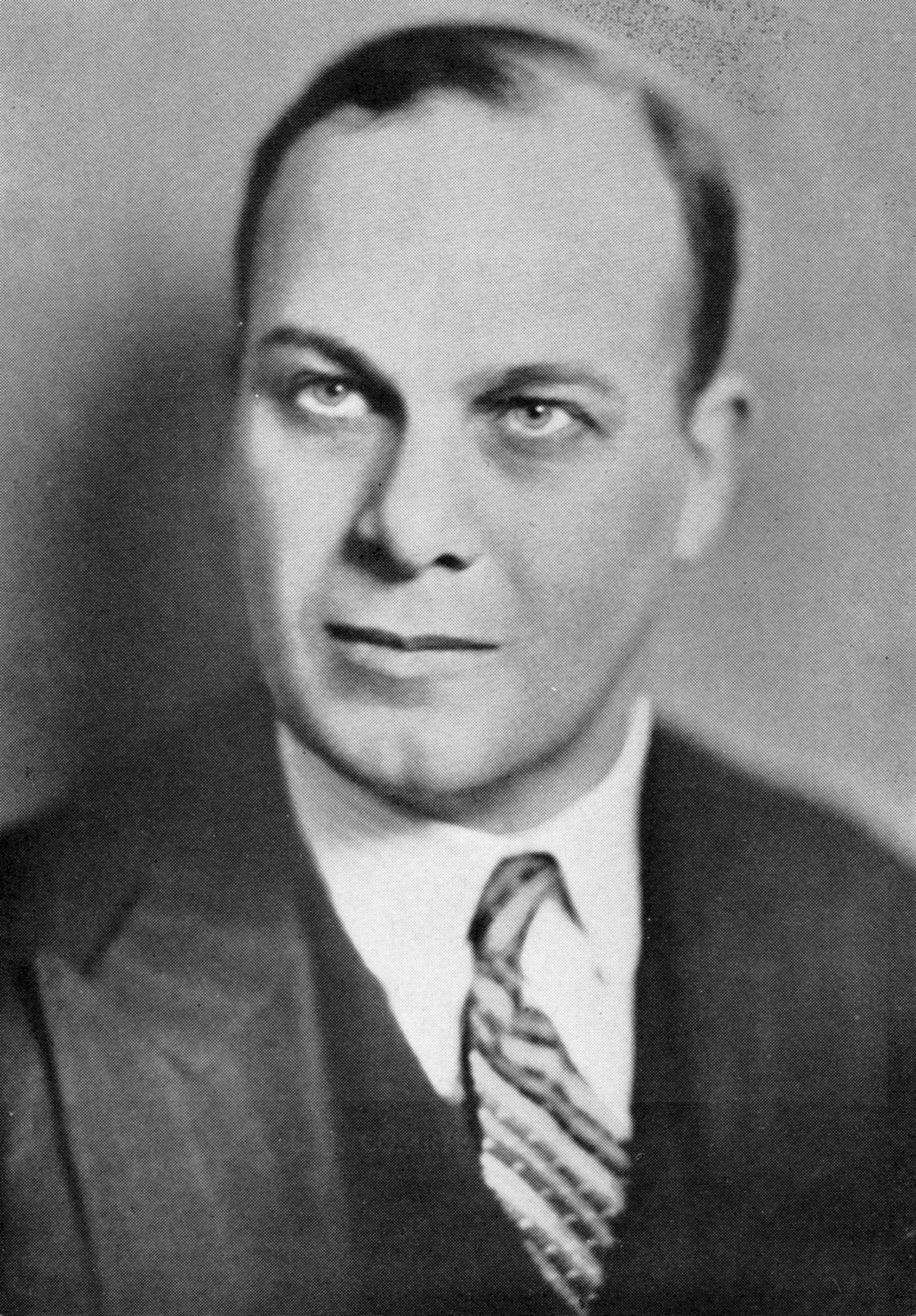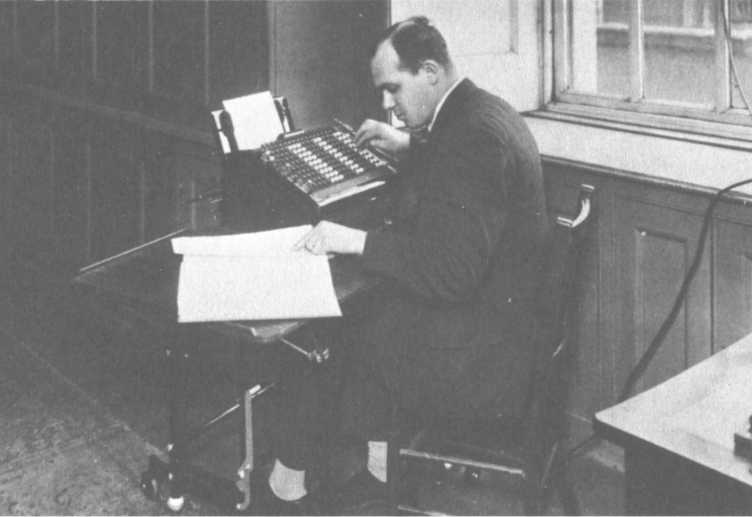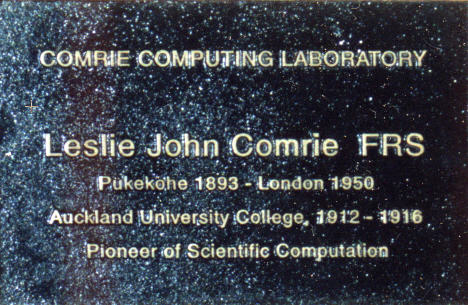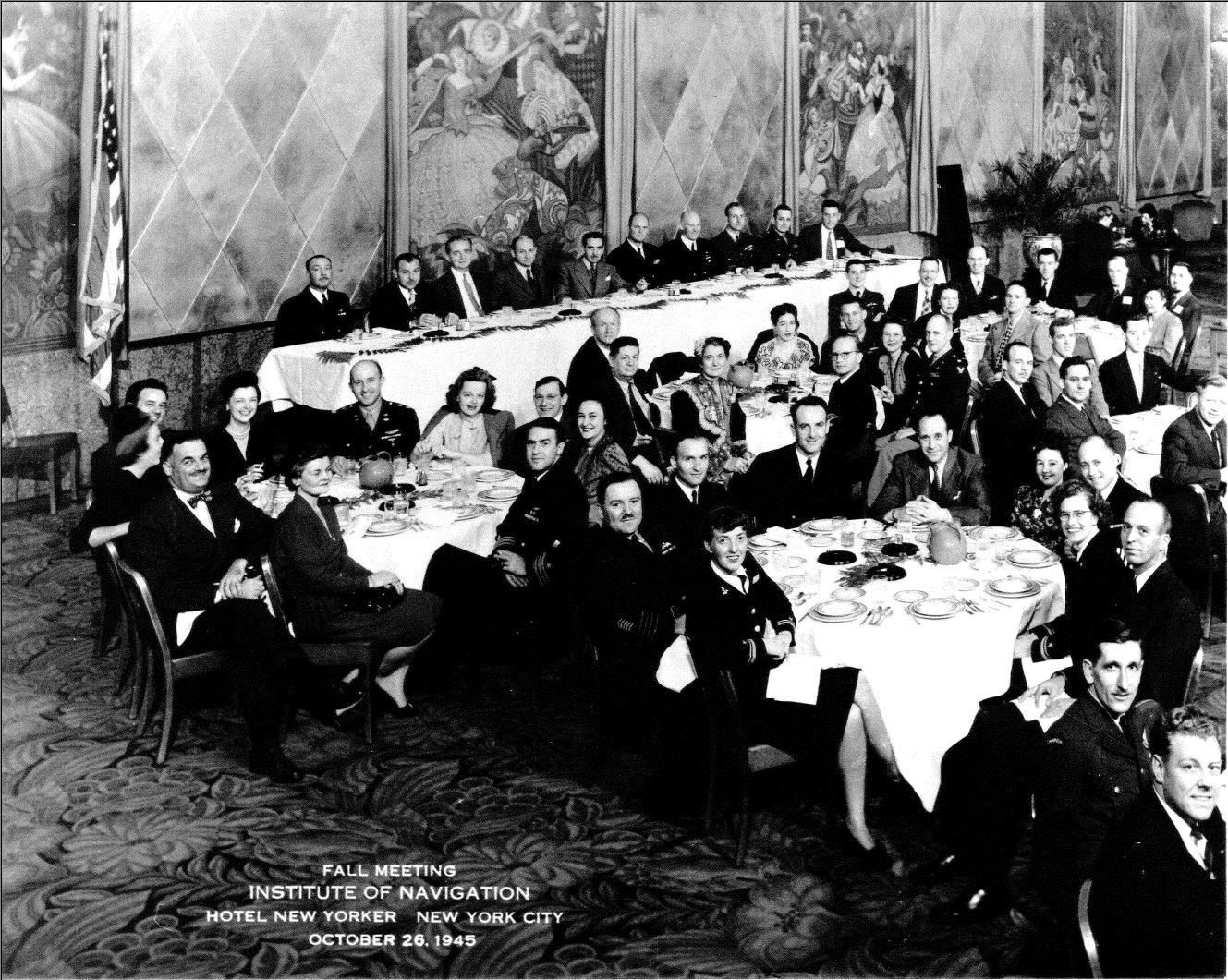L.J. Comrie

|
| Leslie J. Comrie |
Comrie pioneered the teaching of numerical analysis in 1923-25 at Swarthmore College and Northwestern University in the USA, and then joined His Majesty's Nautical Almanac Office in Greenwich. England, in 1926 -- the same year Eckert joined Columbia's Astronomy faculty. Comrie was Superintendent of the Almanac Office from 1930 to 1936 (where, when Comrie arrived in 1925, "the Nautical Almanac was computed by retired Cornish clergymen with long white beards, using dog-eared 7-figure logarithm tables" [Tee 1989]); Eckert was Director of the US Naval Observatory's Nautical Almanac Office from 1940 to 1945.
Comrie was the first to turn punched-card equipment to scientific use: computation of astronomical tables by the method of finite differences, as envisioned by Babbage 100 years earlier for his Difference Engine, but not practical until the appearance of reliable calculating machines. Differencing was used because the early punched-card machines were capable only of addition and subtraction; not division, multiplication, exponentiation, roots, trigonometric functions, etc. Comrie had already been using this method for many years with hand-operated desktop calculators; an excellent review and history of differencing and its application to various types of calculating machines is given in Comrie's 1928 Brunsviga-Dupla article (publication list below).

|
| Comrie at work, Photo: [103]. |
The first scientific application of the Hollerith—in 1928—was to the summation of harmonic terms, or, in other words, Fourier synthesis. In this way the principal terms in the motion of the Moon from 1935 to 2000 were computed. The ordinates of the various harmonics to be compounded were taken from E.W. Brown's Tables of the Moon, and punched on to half a million cards. These were brought together in ever-differing groups; because the periods of the different harmonics are incommensurable, no card ever had the same partners twice, although it may have been used 20 times in the 65 years covered. Something like 100 million figures were added in groups and group totals printed in the course of seven months. I showed this to Brown in the summer of 1928; he had done a great deal of this synthesis himself by hand, and I shall ever remember his ecstasies of rapture as he saw his figures being added at the rate of 20 or 30 a second. I think I am right in saying that the enthusiasm with which he described the process on his return first stimulated W.J. Eckert, the leading American pioneer of these machines for scientific calculation.
In his May, 1932, article, The Application of the Hollerith Tabulating Machine to Brown's Tables of the Moon, Comrie describes his punched-card methods in far greater detail, with paragraphs given over the function and operation of each component -- card, punch, sorter, tabulator, printer -- plus plates showing each. In this article, for the first time, we have a description of "programming":
Automatic Control.—This feature is of the utmost importance in the present application. When the cards corresponding to any one date have been added, the feeding must cease while the total is being printed, the counters must be cleared and then the feeding must be resumed. This sequence is performed automatically, without any attention whatsoever on the part of the operator. (Comrie goes on to describe how the tabulator plugboard has been wired to "compare" a key field on a pair of cards and handle the sums and reset the counters when they differ.)
Further on he says:
A Hollerith installation was used in H.M. Nautical Almanac Office in 1929; actually punching was started six months before the arrival of the sorter and tabulator, as it was necessary to punch 20,000,000 holes in half a million cards. ... The sorter and tabulator, which may only be hired, cost about £2 a day. The cost of doing by hand what was done on the machines has been estimated at £6000; this estimate probably errs on the low side. The cost with the machines was certainly less than £1500.
Thus in the four years since his 1928 article, punched-card computation had become cost effective. In the following years (as can be seen from his publication list, below) Comrie became strong advocate of the punched-card method. Like Eckert, he was preoccupied with saving steps, particularly error-prone and time-consuming ones like copying the results of one calculation to the input of the next. Comrie, unlike Eckert, was happy to use later-model desktop calculators (rather than the more expensive punched-card machines) when they acquired the ability to store results in registers. Of course this was purely a matter of finance; Comrie did not have Thomas J. Watson as a patron, eager to shower him with expensive equipment at no cost!
Comrie was also a strong proponent of using standard, "off-the-shelf", unmodified hardware (calculators or punched-card equipment), rather than modified, one-of-a-kind, or special-purpose machines because he wanted the methods he developed to be useful to others. Eckert, on the other hand, was constantly prodding IBM to modify its designs and to produce special one-off machines for his lab, and IBM was happy to comply. Comrie expressed his feelings in 1946 (same MTAC article), the age of ENIAC, BINAC, EDVAC, EDSAC, ORDVAC, MANIAC, et al.:
The adaptation age has overlapped the beginning of another—namely that of the construction of special machines. I have sometimes felt that physicists and engineers are too prone to ask themselves "What physical, mechanical or electrical analogue can I find to the equation I have to solve?" and rush to the drawing board and lathe before enquiring whether any of the many machines that can be purchased over the counter will not do the job. ... What would not be right in India, where subsistence requirements may almost be measured in handfuls of rice, can easily be justified if computers cost $2000 to $3000 a year plus supervision, administration and costly accommodation. In other words look at what has been provided by and for the industry before you leap to the adventure of a special design.
Eckert was of the opposite persuasion and, through his close contacts with IBM, relentlessly drove modifications and improvements to existing machines to adapt them to scientific use. In 1933-34 he took Comrie's method to the next level by designing a calculation control switch for the machines in his laboratory, thus automating complex series of calculations with a minimum of card handling: this was the first realization of automatic sequencing (the aim of Babbage's Analytical Engine), and a giant step towards modern computing, a step built upon the foundation laid by Comrie.

|
L.J. Comrie was elected Fellow of the Royal Society shortly before his death in 1950. A lunar crater (23.3N 112.7W) and an asteroid bear his name, as does a computer lab at his alma mater, the University of Auckland (left).
Garry Tee of the Department of Mathematics of the University of Auckland adds, "Immediately after the end of World War 2, LJC went to the USA for 3 months, examining developments in computing technology. (The fact that he was able then to get transport so promptly proves that he had very influential friends). He presided at a conference at M.I.T. where some of the wartime computing developments in the UK and USA were described. He gave to Howard Aiken a copy of Charles Babbage's fascinating memoir Passages From The Life Of A Philosopher (London, 1864), inscribed 'From one admirer of Babbage, to another'. But when LJC examined the Harvard Mark 1, he asked where the if-statement was! Aiken gulped and blushed: it was nearly a year later before Aiken got hardware for the if-statement working! The Harvard Mark 1 was thereby converted from a very large calculator, to a very very small computer.
"Herb Grosch invited LJC to attend the 1945 Fall Meeting of the USA Institute of Navigation. I have posted to you some of my papers about LJC, with a copy of the photograph which Herb gave to me of the conference banquet in the Hotel New Yorker on October 26 1945, with LJC seated alongside Herb:"

Photo courtesy of Garry Tee. Click to enlarge.
Comrie and Grosch are near the right edge of the photo, towards the top. Grosch is the one with the goatee; Comrie is to his right. In Grosch's words: "I can identify ten by name, several more by generalities. Around Comrie are [Grosch's wife] Dorothy, goatee, LJC, [Gerald] Clemence, Ralph Haupt (co-author of [Eckert's] c[ard]-o[operated]-typewriter paper [77]), another [Naval Observatory] guy. Third from left on the dais is Sam Herrick. Moonface near camera is Charles Smiley of Brown, editor of Sky and Telescope. There are Hahvahds, some in uniform. No [Fred] Whipple. No Dorrit Hoffleit. Famous Cdr. Weems is on dais also."
- Croarken, M.J., "L.J. Comrie and the origins of the Scientific Computing Service", IEEE Annals of the History of Computing, Vol.21 No.4 (1999), pp.70-71.
- Croarken, M.J., "L.J. Comrie, A forgotten figure in the history of numerical calculation", Mathematics Today, Vol.36 No.4 (Aug 2001), pp.114-118.
- Croarken, Mary, "Computing in Britain During World War II", IEEE History of Technology Summer Meeting (6 July 2002).
- Grier, David Alan, "The Rise and Fall of the Committee on Mathematical Tables and Other Aids to Computation", IEEE Annals of the History of Computing (April-June 2001).
- Grier, David Alan, "The Human Computer and the Birth of the Information Age", Philosophical Society of Washington: Joseph Henry Lecture (11 May 2001).
- Grosch, Herbert R.J., Computer: Bit Slices from a Life, Third Edition, 2003 (in manuscript). First edition published by Third Millenium Books, Novato CA (1991) [57].
- Sadler, D. H., "Comrie, Leslie John", in Gillispie, Charles Couston (Ed.) Dictionary of Scientific Biography, Charles Scribner's Sons, NY (1970-80).
- Tee, Garry J., "Two New Zealand Mathematicians", History of Mathematics: Proceedings of the First Australian Conference, Monash University, Clayton VIC (1980).
- Tee, Garry J., "New Zealand and the Pioneers of Early Computing", New Zealand Journal of Computing, Vol.1 No.2 (Dec 1989).
- Wilkes, Maurice, "Babbage's Expectations for his Engines", IEEE Annals of the History of Computing, Vol.13 (1991), pp.141-145.
- "Computing Expert Dr. L. J. Comrie back from United States", New Zealand News (London), January 1, 1946. Reports that LJC presided at the conference of British and American experts on scientific computing machines, held at MIT.
- "Noted Mathematician returns to New Zealand after long absence", New Zealand Free Lance, January 7, 1948. Tells that, on the ship from Sydney to Wellington, Comrie met Dr. Stuart Barton Babbage, a great-great grandson of Charles Babbage, born in Auckland, who was then the Anglican Dean of Sydney. (Still flourishing in 2002.)
- "From Pukehohe to the Nautical Almanac", New Zealand Listener, January 16, 1948.
- Massey, H.S.W., Obituary Notices of Fellows of the Royal Society, Vol.8 (1953), pp.97-107 (many of the publications listed below are cited here). Obituary articles about Comrie were also published in many scientific journals and in many newspapers. Two particularly interesting newspaper obituaries: "Death of Dr. L. J. Comrie", The Blackheath Local Record, December 30 1950; and "Dr. L. J. Comrie, A computer of genius", The Times, January 5, 1951.
- Eames, Charles and Ray, A Computer Perspective: Background to the Computer Age, Harvard University Press. First Edition 1973; Second Edition 1990 [103].
- Comrie, L.J., Handbook, British Astronomical Association (1922). Astronomical tables; the precursor to the British Nautical Almanac.
- Comrie, L.J., "The Application of Calculating Machines to Astronomical Computing", Popular Astronomy, Vol.33 (1925), 1-4. Comrie's lecture at the American Astronomical Society annual meeting, Washington DC, 31 December 1924, reporting that multiplication and division could be done by machines more quickly than with logarithms, and announcing his intention to abolish logarithms for multiplication and division.
- Comrie, L.J., "Logarithmic and trigonometrical tables", Mon. Not. Roy. Astr. Soc., Vol.85 (1925), p.386.
- Comrie, L.J., "A method of extending an n-figure table to n+1 figures", Journal of the British Astronomical Association, Vol.36 (1926), pp.248-252 (plus several reviews on pages 200-204, 258-259, 262-264 & 339-341).
- Comrie, L.J., "Computing by calculating machines", The Accountant's Journal (May 1927), 45, 42.
- Comrie, L.J., "Some computational problems arising in eclipses", Mon. Not. Roy. Astr. Soc., Vol.87 (1927), p.487.
- Comrie, L.J., "On the Application of the Brunsviga-Dupla Calculating Machine to Double Summation with Finite Differences", Monthly Notices of the Royal Astronomical Society (MNRAS), Vol.88, pp.447-459 (1928).
- Comrie, L.J., "On the Construction of Tables by Interpolation", Monthly Notices of the Royal Astronomical Society, Vol.88, pp.518-521 (1928).
- Comrie, L.J., Recent Developments in Calculating Machines, Office Machinery Users' Association Transactions (1927-1928). Critique and comparison of various calculating and tabulating machines that were commercially available at the time, including Burroughs and Hollerith models.
- Comrie, L.J., "Professional work in Departments of State", His Majesty's Nautical Almanac Office, State Service (June 1928), 6 pages.
- Comrie, L.J., "Tables for Interpolation to Tenths and Fifths by the End Figure Process", Nautical Almanac for 1931, HM Stationery Office, London (1929), pp.828-835.
- Comrie, L.J., "Mathematical tables", Brit. Astr. Soc. Handbook (1929), p.38.
- Comrie, L.J., "Errata in the Napier Tercentenary Memorial Handbook and in the Encyclopaedia Britannica", Observatory, Vol.52 (1929), p.324.
- Comrie, L.J., "German Calculating Machine Enterprise", Transactions of the Office Machinery Users' Association (1929-30), 4 pages.
- Comrie, L.J. "The Hollerith and Powers Tabulating Machines", Transactions of the Office Machinery Users' Association, pp.25-37 (1929-30) (updated and elarged version published for private circulation in 1933. 48 pages). Donald Knuth cites this article in Volume 3 of the Art of Computer Programming: Sorting and Searching (1973) as the source of the radix sort.
- L.J. Comrie., Barlow's Tables of Squares, Cubes, Square Roots, Cube Roots and Reciprocals of all Integer Numbers up to 10,000, (3rd edition), Spon, London (1930).
- Comrie, L.J. & L. M. Milne-Thomson, Standard Four-figure Mathematical Tables, Macmillan, London (1931).
- Comrie, L.J., "Note on Mr. Chappell's method of second-difference integration", Mon. Not. Roy. Astr. Soc., Vol.91 (1931), p.819.
- Comrie, L.J., "Tables for interpolation to tenths and fifths by the end-figure process", Nautical Almanac, Appendix (1931).
- Comrie, L.J., "The Nautical Almanac Office Burroughs Machine", Monthly Notices of the Royal Astronomical Society, Vol.92, No.6, pp.523-541 (1932).
- Comrie, L.J., "The application of the Hollerith Tabulating Machine to Brown's Tables of the Moon", Monthly Notices of the Royal Astronomical Society, Vol.92, No.7, pp.694-707 (1932).
- Comrie, L.J., and Dr. Harold Jeffreys, "A smoothing device applied to the new seismological tables", Monthly Notices of the Royal Astronomical Society, Geophysical Supplement, (January 1932), Vol.3 No.1, 10-13.
- Comrie, L.J., "Mathematical Tables", Mon. Not. Roy. Astr. Soc., Vol.92 (1932), p.339.
- Comrie, L.J., "Modern Babbage Machines", Bulletin of The Office Machinery Users' Association, London (1933), 29 pages. Comrie reported his discovery that the National Accounting Machine Company had inadvertently manufactured a Babbage Difference Engine.
- Comrie, L.J., "Computing the Nautical Almanac", Nautical Magazine (July 1933), pp.33-48.
- Comrie, L.J., "The computation of total solar eclipses", Monthly Notices of the Royal Astronomical Society, Vol.93, No.3 (January 1933), pp.175-181.
- Comrie, L.J., "Adding machines", and "Calculating machines", in Hutchinson's Technical and Scientific Encyclopaedia (1934).
- Comrie, L.J., "Mechanical Computing", in Clark's Plane and Geodetic Surveying (2nd edition), Vol.2, Appendix, Constable, London (1934).
- Comrie, L.J., "Inverse interpolation. Scientific applications of the National Accounting Machine", J. Roy. Stat. Soc., Vol.3 (1936), p.87.
- Comrie, L.J., "Interpolation and Allied Tables". H.M. Stationery Office, London (1936). Reprinted from the Nautical Almanac for 1937, pp.786-940. Several reprints, with a new edition in 1956.
- Comrie, L.J. et al., "The application of Hollerith equipment to an agricultural investigation", Journal of the Royal Statistical Society Supplement, 4(2), 210-224 (1937). A major advance in applications of the punched-card multiplier.
- Comrie, L.J., "Scientific Computing Service", Offered by L. J. Comrie, 131 Maze Hill, Blackheath (1937). 8 pages.
- Comrie, L.J., "Air navigation", Nautical Magazine (August 1937), 4 pages.
- Comrie, L.J., "The application of the Brunsviga Twin 13Z calculating machine to the Hartmann formula for the reduction of prismatic spectrograms", Observatory 60 (1937), p.70.
- Comrie, L.J., "Dr J. R. Airey", Nature 140 (November 6, 1937), 796. Obituary article.
- Comrie, L.J., "Scientific Computing Service Limited, a Description of its Activities, Equipment and Staff", London (1938), 16 pages.
- Comrie, L.J., "The Geocentric Direction Cosines of Seismological Observatories", British Association for the Advancement of Science, London (1938), 8+14 pages.
- Comrie, L.J., "On the application of the Brunsviga Twin 13Z calculating machine to artillery survey", Scientific Computing Service Ltd. (1938).
- Comrie, L.J., "Calculating machines", Appendix 3 to L. R. Connor's Statistics in Theory and Practice, London, Pitman (1938), pp.349-371.
- Comrie, L.J., Hughes's Tables for Sea and Air Navigation, Henry Hughes & Son Ltd, London (1938).
- Comrie, L.J., "Tables of tan-1x and log(1+x2) to assist in the calculation of the ordinates of a Pearson Type IV curve", Tracts for Computers, no.23, p.18, Cambridge University Press, Cambridge (1938).
- Comrie, L.J., "On the Application of the Brunsviga Twin 13Z Calculating Machine to Survey Problems", Scientific computing Service, London (1940), 18 pages.
- Comrie, L.J., "Review of W. J. Eckert, 'Punched Card Methods in Scientific Computation'", Nature 147 (February 1, 1941), p.131.
- Comrie, L.J., "The use of calculating machines in ray tracing", Proc. Phys. Soc., Vol.52 (1940), p.246.
- Comrie, L.J., "The correction of epicentres by least squares", Mon. Not. Roy. Astr. Soc., Vol.5 (1940), Geophysical Supplement, p.27.
- Comrie, L.J., "On the calculation of correlation coefficients with modern calculating machines", Journal of the American Statistical Association (September 1941), Vol.36, p.429.
- Thompson, Catherine M., E. S. Pearson, L. J. Comrie & H .O. Hartley, "Tables of Percentage Points of the Incomplete Beta-Function", Biometrika, Vol.32 No.2 (October 1941), pp.151-181.
- Comrie, L.J. and H. O. Hartley, "A table of Lagrangian coefficients for harmonic interpolation in certain tables of percentage points", Biometrika Vol.32 No.2 (October 1941), pp.183-186.
- Comrie, L.J. (editor), Barlow's Tables of Squares, Cubes, Square Roots, Cube Roots and Reciprocals of all Integer Numbers up to 12,500, 4th Edition, Spon, London (1941).
- Comrie, L.J., "George Lawson, M.A.", Proc. Edinburgh Math. Soc. (2) 6, (1941). pp.261-262. Obituary article.
- Comrie, L.J., "Eight-figure natural tables for every second of arc", Empire Surv., Rev 8 (1943), p.42.
- Comrie, L.J., "The Twin Marchant Calculating Machine and its Application to Survey Problems", Scientific Computing Service Limited, London, 2nd printing (1943), 40 pages.
- Comrie, L.J., "Recent Progress in Scientific Computing", Journal of Scientific Instruments, Vol.21, No.8 (Aug 1944), pp.129-135 (also letters and further commentary in the Dec 1944 issue, pp.218-219).
- Comrie, L.J., "Careers for Girls", The Mathematical Gazette (July 1944), p.90.
- Comrie, L.J., Review of R. M. Page's "14,000 Gear Ratios", MTAC Vol.1 No.8 (October 1944), 326-329; and V.1 No.11 (July 1945), 430.
- Comrie, L.J., "Mechanical Computing", in Clark's Plane and Geodetic Surveying, (3rd edition), Vol.2, Appendix, Constable, London (1944).
- Comrie, L.J., "The Twin Marchant Calculating Machine and its Application to Survey Problems", Scientific computing Service Limited, London, 3rd printing (1945), 40 pages,
- Comrie, L.J., "Errata in Jahnke & Emde's Tables of FUnctions", Math. Tab. Wash., Vol.1 (1945), p.391.
- Comrie, L.J., "Babbage's Dream Comes True", Nature, Vol.159 (1946), pp.567-568 (a review of the Harvard/IBM ASCC).
- Comrie, L.J., The Application of Commercial Calculating Machines to Scientific Computation", Mathematical Tables and Other Aids to Computation (MTAC), Vol.2 No.16, pp.149-159 (1946).
- Comrie, L.J., "Scientific Computing Service Limited, a Description of its Activities, Equipment and Staff", London (1946), 24 pages.
- Comrie, L.J. "Calculating--past, present, and future," Future, the Magazine of Industry, Government, Science, Arts, No.1 (1947), "Overseas Issue," p.61-69.
- Comrie, L.J., Chambers's Four-Figure Mathematical Tables, W. & R. Chambers, Edinburgh & London (1947).
- L.J. Comrie., Barlow's Tables of Squares, etc. of Integral Numbers up to 12,500 (4th edition), Spon, London (1947).
- Comrie, L.J. Mathematics in War, Auckland Radio Station 1YA Broadcast, 7:00pm, 5 April 1948, recorded on two 78rpm vinyl platters held at the Royal Society London Library. NOW ONLINE at the Royal Society of New Zealand.
- Comrie, L.J. Chambers's Six-Figure Mathematical Tables, W&R Chambers, London & Edinburgh (Vol.1: 1948; Vol.2: 1949). Logarithmic and Trigonometric tables; this work was in print for almost 30 years.
- Comrie, L.J., Chambers's Shorter Six-Figure Mathematical Tables, W. & R. Chambers, Edinburgh & London (1950).
- Comrie, L.J., "Scientific Computing Service Limited, a Description of its Activities, Equipment and Staff", London (1950), 23 pages.
- Bickley, W. G.; Comrie, L. J.; Miller, J. C. P.; Sadler, D. H. and Thompson, A. J., "Bessel functions. Part II. Functions of positive integer order", British Association for the Advancement of Science, Mathematical Tables, Vol.X. University Press, Cambridge (1952).
- Fletcher, A.; Miller, J. C. P.; Rosenhead, L. & Comrie, L.J. An index of mathematical tables (2 volumes), Second edition, published for Scientific Computing Service Ltd., London, by Addison-Wesley Publishing Co., Inc., Reading, Mass (1962).
- Comrie, L.J., "Occultation of a star by Saturn", J. Brit. Astr. Assn., Vol.30 (1920), p.215.
- Comrie, L.J., "Occultation of a star by Jupiter", J. Brit. Astr. Assn., Vol.30 (1920), p.215.
- Comrie, L.J., "Phenomena of Saturn's satellites", J. Brit. Astr. Assn., Vol.30 (1920), p.292.
- Comrie, L.J. & M. Levin, "Eclipse of Rhea by the shadow of Saturn", Mon. Not. Roy. Astr. Soc., Vol.81 (1921), p.486.
- Comrie, L.J., "New Zealand observations during the lunar eclipse of 1921, April 21", Mon. Not. Roy. Astr. Soc., Vol.82 (1921), p.303.
- Comrie, L.J., "Stars and occultations during lunar eclipses in 1921", Mon. Not. Roy. Astr. Soc., Vol.82 (1921), p.304
- Comrie, L.J., "Phenomena of Saturn's satellites", J. Brit. Astr. Assn., Vol.31 (1921), pp. 83, 118, 160, 172.
- Comrie, L.J., "Occultation of a star by Venus", J. Brit. Astr. Assn., Vol.31 (1921), p.302.
- Comrie, L.J., "Occultation of a star by Mars", J. Brit. Astr. Assn., Vol.31 (1921), p.332.
- Comrie, L.J., "Path of Uranus in 1922", J. Brit. Astr. Assn., Vol.32 (1922), p.182.
- Comrie, L.J., "Planetary occultations", J. Brit. Astr. Assn., Vol.34 (1924), p.238.
- Comrie, L.J., "The use of a standard equinox in astronomy", Mon. Not. Roy. Astr. Soc., Vol.86 (1926), p.618.
- Comrie, L.J., "The total solar eclipse of 1940, October 1", Mon. Not. Roy. Astr. Soc., Vol.93 (1932), p.181.
- Croarken, M., "New Zealand Newspaper Articles about L.J. Comrie".
- Rollo, Lindsay, "The Typography of Tables: A note on L.J. Comrie", KOTARE New Zealand Notes & Queries, School of English, Film, and Theatre, Victoria University of Wellington, New Zealand, Volume Four, Number One, June 2001.
- Rollo, Lindsay, "A Benevolent Astronomer - Further Notes on L.J. Comrie", KOTARE, Volume Five, Number One, 2004. Also available locally in PDF format.
- Rollo, Lindsay, "Notes supporting documents about Leslie John Comrie".
- Rollo, Lindsay, "Holdings of Howard C. Smith".
- L.J. Comrie Biography, The Royal Society of New Zealand. Includes a link to an MP3 audio file of Comrie's 1948 interview, "Mathematics in War".
- Comrie Lecture 2000 (Garry Tee, University of Auckland).
- Scientific Computing Service Ltd. (about Comrie's company, founded 1936).
- The British Astronomical Association. The First Fifty Years (Computing Section).
- Her Majesty's Nautical Almanac Office.
- Charles Babbage (A.N. Lee, Virginia Polytechnic Institute).
Grateful thanks to Garry Tee of the Mathematics Department of the University of Auckland for his many contributions to this page, and to Lindsay Rollo of Wellington, NZ.